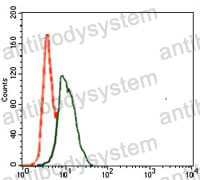Catalog No.
RHD27302
Species reactivity
Human
Host species
Mouse
Isotype
IgG1
Clonality
Monoclonal
Tested applications
ELISA: 1:10000, FCM: 1:200-1:400
Target
31 kDa-transforming protein, SPI1, Transcription factor PU.1
Concentration
1 mg/ml
Endotoxin level
Please contact with the lab for this information.
Purity
>95% as determined by SDS-PAGE.
Purification
Protein A/G purified from cell culture supernatant.
Accession
P17947
Applications
ELISA, FCM
Form
Liquid
Storage buffer
0.01M PBS, pH 7.4, 0.05% Sodium Azide.
Stability and Storage
Use a manual defrost freezer and avoid repeated freeze-thaw cycles. Store at 4°C short term (1-2 weeks). Store at -20°C 12 months. Store at -80°C long term.
Clone ID
R3E90
Functional multiomics reveals genetic and pharmacologic regulation of surface CD38 in multiple myeloma., PMID:40453054
Protease-activated receptor 2 and interleukin-13 receptor α1 activation is linked to eosinophilic chronic rhinosinusitis., PMID:40074076
Spatiotemporal transcriptomics elucidates the pathogenesis of fulminant viral myocarditis., PMID:39924580
Integrative Bioinformatics Analysis and Experimental Study of NLRP12 Reveal Its Prognostic Value and Potential Functions in Ovarian Cancer., PMID:39601513
The mechanism underlying B-cell developmental dysfunction in Kawasaki disease based on single-cell transcriptomic sequencing., PMID:39507528
Macrophages Promote Atherosclerosis Development by Inhibiting CD8T Cell Apoptosis., PMID:39345351
Immunoregulatory Effect of Calcitriol on Experimental Autoimmune Encephalomyelitis (EAE) Mice., PMID:38085147
Salmonella Typhimurium-based inactivated vaccine containing a wide spectrum of bacterial antigens which mimics protein expression changes during different stages of an infection process., PMID:37141806
An innovative immunotherapeutic strategy for rheumatoid arthritis: Selectively suppressing angiogenesis and osteoclast differentiation by fully human antibody targeting thymocyte antigen-1., PMID:36706943
Blocking GM-CSF receptor α with mavrilimumab reduces infiltrating cells, pro-inflammatory markers and neoangiogenesis in ex vivo cultured arteries from patients with giant cell arteritis., PMID:35045965
Genomics of Alzheimer's disease implicates the innate and adaptive immune systems., PMID:34708251
Identification of Key Genes and Underlying Mechanisms in Acute Kawasaki Disease Based on Bioinformatics Analysis., PMID:34290221
Novel Template Plasmids pCyaA'-Kan and pCyaA'-Cam for Generation of Unmarked Chromosomal cyaA' Translational Fusion to T3SS Effectors in Salmonella., PMID:33668764
The Hha-TomB toxin-antitoxin module in Salmonella enterica serovar Typhimurium limits its intracellular survival profile and regulates host immune response., PMID:33651227
Leishmania amazonensis Promastigotes or Extracellular Vesicles Modulate B-1 Cell Activation and Differentiation., PMID:33194814
Salmonella Typhimurium Lacking YjeK as a Candidate Live Attenuated Vaccine Against Invasive Salmonella Infection., PMID:32655567
Transcription factors IRF8 and PU.1 are required for follicular B cell development and BCL6-driven germinal center responses., PMID:31000603
PU.1 Regulates Ig Light Chain Transcription and Rearrangement in Pre-B Cells during B Cell Development., PMID:28062693
A Genome-Wide siRNA Screen Implicates Spire1/2 in SipA-Driven Salmonella Typhimurium Host Cell Invasion., PMID:27627128
Enforced Expression of Hoxa3 Inhibits Classical and Promotes Alternative Activation of Macrophages In Vitro and In Vivo., PMID:27342843
phoP, SPI1, SPI2 and aroA mutants of Salmonella Enteritidis induce a different immune response in chickens., PMID:26380970
RpoS-dependent expression of OsmY in Salmonella enterica serovar typhi: activation under stationary phase and SPI-2-inducing conditions., PMID:25820138
Virulence determinants of Salmonella Gallinarum biovar Pullorum identified by PCR signature-tagged mutagenesis and the spiC mutant as a candidate live attenuated vaccine., PMID:24355532
A myelopoiesis gene signature during remission in anti-neutrophil cytoplasm antibody-associated vasculitis does not predict relapses but seems to reflect ongoing prednisolone therapy., PMID:24215168
IL-10 produced by trophoblast cells inhibits phagosome maturation leading to profound intracellular proliferation of Salmonella enterica Typhimurium., PMID:23834952
Vaccination of chickens with SPI1-lon and SPI1-lon-fliC mutant of Salmonella enterica Serovar Enteritidis., PMID:23785484
Chicken innate immune response to oral infection with Salmonella enterica serovar Enteritidis., PMID:23687968
SPI1 defective mutants of Salmonella enterica induce cross-protective immunity in chickens against challenge with serovars Typhimurium and Enteritidis., PMID:23684831
Membrane topology of Salmonella invasion protein SipB confers osmotolerance., PMID:22975346
Salmonella Typhimurium induces SPI-1 and SPI-2 regulated and strain dependent downregulation of MHC II expression on porcine alveolar macrophages., PMID:22694285
Association of a protective monoclonal IgA with the O antigen of Salmonella enterica serovar Typhimurium impacts type 3 secretion and outer membrane integrity., PMID:22473607
IgG keeps virulent Salmonella from evading dendritic cell uptake., PMID:22352313
Vaccination of chickens with Salmonella Pathogenicity Island (SPI) 1 and SPI2 defective mutants of Salmonella enterica serovar Enteritidis., PMID:22300724
Immunization of chickens with Salmonella enterica subspecies enterica serovar Enteritidis pathogenicity island-2 proteins., PMID:21684090
Role of Salmonella Pathogenicity Island 1 protein IacP in Salmonella enterica serovar typhimurium pathogenesis., PMID:21263021
SopB effector protein of Salmonella Typhimurium is translocated in mesenteric lymph nodes during murine salmonellosis., PMID:21241360
Evaluation of Salmonella enterica serovar Enteritidis pathogenicity island-1 proteins as vaccine candidates against S. Enteritidis challenge in chickens., PMID:20888713
Protection of epithelial cells from Salmonella enterica serovar Enteritidis invasion by antibodies against the SPI-1 type III secretion system., PMID:20657623
Salmonella-containing vacuoles display centrifugal movement associated with cell-to-cell transfer in epithelial cells., PMID:19103768
SpvC is a Salmonella effector with phosphothreonine lyase activity on host mitogen-activated protein kinases., PMID:18284579
Entry route of Salmonella typhimurium directs the type of induced immune response., PMID:18083577
Role in virulence and protective efficacy in pigs of Salmonella enterica serovar Typhimurium secreted components identified by signature-tagged mutagenesis., PMID:17526851
Impact of Salmonella Typhimurium DT104 virulence factors invC and sseD on the onset, clinical course, colonization patterns and immune response of porcine salmonellosis., PMID:17524577
SipA, SopA, SopB, SopD and SopE2 effector proteins of Salmonella enterica serovar Typhimurium are synthesized at late stages of infection in mice., PMID:17379731
Spi-1 and Spi-B control the expression of the Grap2 gene in B cells., PMID:15936902
Alterations of loci encoding PU.1, BOB1, and OCT2 transcription regulators do not correlate with their suppressed expression in Hodgkin lymphoma., PMID:15796964
Induction of potent humoral and cell-mediated immune responses by attenuated vaccinia virus vectors with deleted serpin genes., PMID:14990697
The putative gymnosperm plant defensin polypeptide (SPI1) accumulates after seed germination, is not readily released, and the SPI1 levels are reduced in Pythium dimorphum-infected spruce roots., PMID:12856937
Salmonella effectors within a single pathogenicity island are differentially expressed and translocated by separate type III secretion systems., PMID:11918798
Salmonella pathogenicity island 2-dependent macrophage death is mediated in part by the host cysteine protease caspase-1., PMID:11736994

